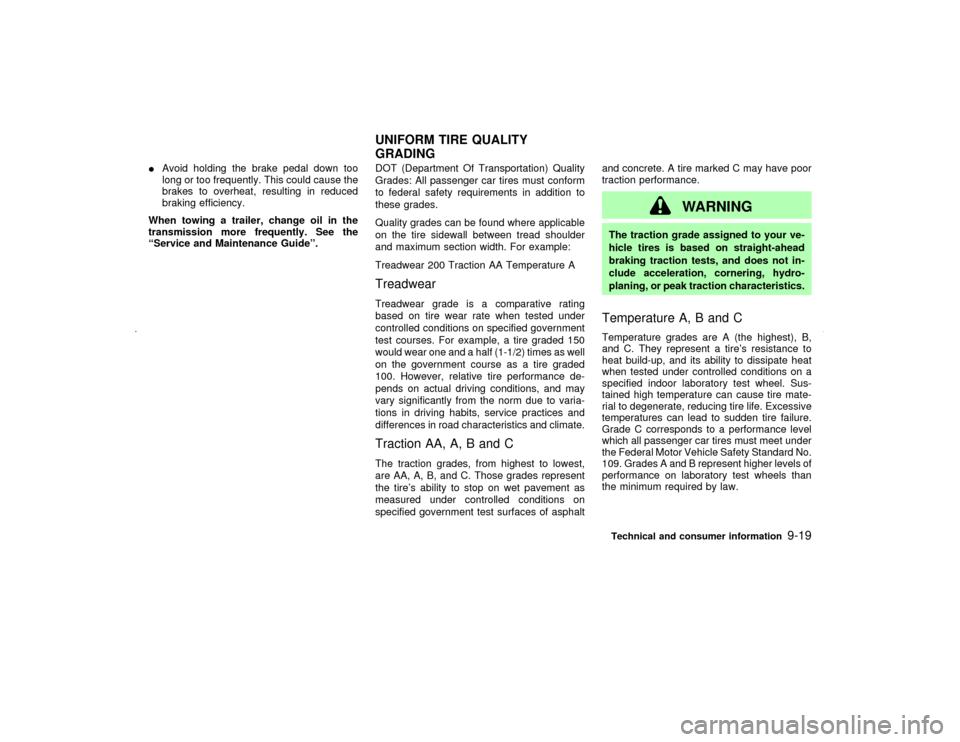width NISSAN MAXIMA 2002 A33 / 5.G Owners Manual
[x] Cancel search | Manufacturer: NISSAN, Model Year: 2002, Model line: MAXIMA, Model: NISSAN MAXIMA 2002 A33 / 5.GPages: 247, PDF Size: 1.98 MB
Page 224 of 247

WHEELS AND TIRESRoad wheelType Size Offset in (mm)
Aluminum16 x 6-1/2JJ
17 x 7JJ
17 x 7JJ (option)1.57 (40)
1.57 (40)*2
1.75 (45)*3
TireConventionalP215/55R16 91H
P215/55R17 93H
P225/50R17 93V
SpareConventional*1
T125/70D16
T125/90D16
T135/70D16
T135/90D16
*1: For option
*2: For P215/55R17 91H
*3: For P225/50R17 93V
DIMENSIONS AND WEIGHTS
Sedan
Overall length in (mm) 191.5 (4,863)
Overall width in (mm) 70.3 (1,785)
Overall height in (mm)56.3 (1,430)*3
56.7 (1,440)*4
57.1 (1,450)*5
Front tread in (mm)60.2 (1,530)*1
59.8 (1,520)*2
Rear tread in (mm)59.4 (1,510)*1
59.1 (1,500)*2
Wheelbase in (mm) 108.3 (2,750)
Gross vehicle weight rating lb (kg)
See the F.M.V.S.S. certifica-
tion label on the driver's side
lock pillar. Gross axle weight rating
Front lb (kg)
Rear lb (kg)
*1: For models with road wheel size - 16 x 6.5JJ, 17 x 7JJ (offset 1.57 in (40 mm))
*2: For models with aluminum wheel size - 17 x 7JJ (offset 1.75 in (45 mm))
*3: For models with the tire size P215/55R16 91H
*4: For models with the tire size P225/50R17 93V
*5: For models with the tire size P215/55R17 93H
Technical and consumer information
9-9
Z
01.9.21/A33-D/V5.0
X
Page 234 of 247

IAvoid holding the brake pedal down too
long or too frequently. This could cause the
brakes to overheat, resulting in reduced
braking efficiency.
When towing a trailer, change oil in the
transmission more frequently. See the
ªService and Maintenance Guideº.DOT (Department Of Transportation) Quality
Grades: All passenger car tires must conform
to federal safety requirements in addition to
these grades.
Quality grades can be found where applicable
on the tire sidewall between tread shoulder
and maximum section width. For example:
Treadwear 200 Traction AA Temperature A
TreadwearTreadwear grade is a comparative rating
based on tire wear rate when tested under
controlled conditions on specified government
test courses. For example, a tire graded 150
would wear one and a half (1-1/2) times as well
on the government course as a tire graded
100. However, relative tire performance de-
pends on actual driving conditions, and may
vary significantly from the norm due to varia-
tions in driving habits, service practices and
differences in road characteristics and climate.Traction AA, A, B and CThe traction grades, from highest to lowest,
are AA, A, B, and C. Those grades represent
the tire's ability to stop on wet pavement as
measured under controlled conditions on
specified government test surfaces of asphaltand concrete. A tire marked C may have poor
traction performance.
WARNING
The traction grade assigned to your ve-
hicle tires is based on straight-ahead
braking traction tests, and does not in-
clude acceleration, cornering, hydro-
planing, or peak traction characteristics.Temperature A, B and CTemperature grades are A (the highest), B,
and C. They represent a tire's resistance to
heat build-up, and its ability to dissipate heat
when tested under controlled conditions on a
specified indoor laboratory test wheel. Sus-
tained high temperature can cause tire mate-
rial to degenerate, reducing tire life. Excessive
temperatures can lead to sudden tire failure.
Grade C corresponds to a performance level
which all passenger car tires must meet under
the Federal Motor Vehicle Safety Standard No.
109. Grades A and B represent higher levels of
performance on laboratory test wheels than
the minimum required by law.
UNIFORM TIRE QUALITY
GRADING
Technical and consumer information
9-19
Z
01.9.21/A33-D/V5.0
X